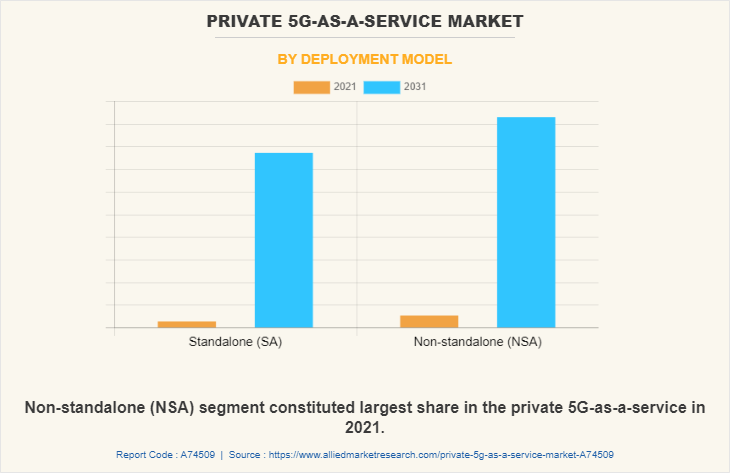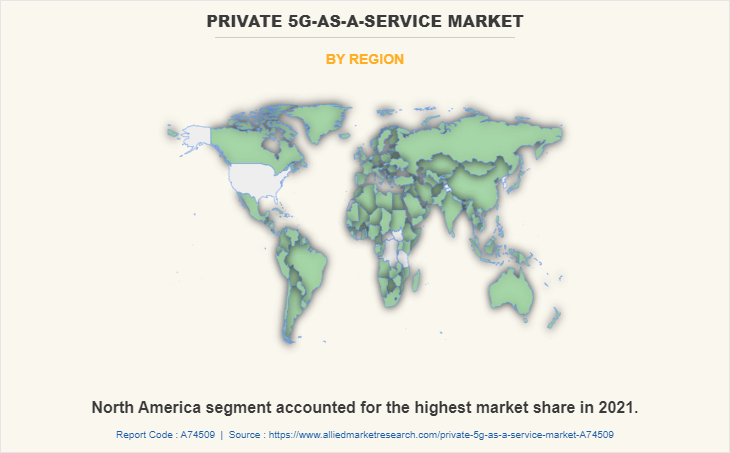Private 5G-as-a-Service Market Insights:
The global private 5g-as-a-service market was valued at USD 1.6 billion in 2021, and is projected to reach USD 34.1 billion by 2031, growing at a CAGR of 36.2% from 2022 to 2031.
Private 5G-as-a-service refers to a telecommunications service that provides organizations with a dedicated and managed private 5G network infrastructure that is operated and maintained by a third-party provider. The private 5G network is deployed exclusively for the use of the organization and is not shared with any other users. The service provider installs and maintains the necessary equipment, including base stations and other network components and manages the network infrastructure to ensure optimal performance and security. Private 5G-as-a-service can be customized to meet the specific needs and requirements of different organizations, making it a highly versatile and adaptable solution.

Private 5G-as-a-service is used across three main types of connected services, including enhanced mobile broadband, mission-critical communications, and the massive IoT. Private 5G-as-a-service is designed for forward compatibility, which means it can be integrated with a lot of devices including smartphones, laptops, and security systems. Furthermore, it has the ability to flexibly support future services that require faster internet speed and ultra-low latency levels.
In addition to making smartphones better, 5G mobile technology can usher in new immersive experiences such as VR and AR with faster, more uniform data rates, lower latency, and lower cost-per-bit. 5G can enable new services that can transform industries with ultra-reliable, available, low-latency links such as remote control of critical infrastructure, vehicles, and medical procedures. Depending on the industry, some businesses can make full use of 5G capabilities, especially those needing the high speed, low latency, and network capacity that 5G is designed to provide. For example, smart factories could use 5G to run industrial Ethernet to help them increase operational productivity and precision.
The report includes the study of the global private 5G-as-a-service market with respect to the growth prospects and restraints based on the regional analysis. The study includes Porter’s five forces analysis of the industry to determine the impact of suppliers, competitors, new entrants, substitutes, and buyers on the market growth.
Segment Review:
The private 5G-as-a-service market is segmented into component, frequency band, deployment model, spectrum, industry vertical, and region. By component, it is classified into hardware, software, and service. Depending on frequency band, it is segregated into sub-6 GHz and mmWave. On the basis of deployment model, it is segregated into standalone (SA) and non-standalone (NSA). Depending on spectrum, it is divided into licensed and unlicensed/shared. As per industry vertical, the market is divided into BFSI, transportation & logistics, IT, manufacturing, healthcare, media & entertainment, and others. Region wise, it is analyzed across North America, Europe, Asia-Pacific, and LAMEA.

By deployment model, the standalone (SA) segment constituted the largest private 5G-as-a-service market share in 2021. This is attributed to the fact that this deployment model provides high bandwidth and low latency, making them ideal for applications that require high-speed data transfer and ultra-low latency, such as autonomous vehicles and industrial automation.

By region, North America dominated the private 5G-as-a-service market size in 2021. This is attributed to the fact that many businesses in North America are undergoing digital transformation, which is driving demand for advanced connectivity solutions such as private 5G networks. Further, increase in adoption of Internet of Things (IoT) is driving the demand for private 5G networks, as businesses look for ways to connect and manage large numbers of IoT devices securely and efficiently.
The report analyzes the profiles of key players operating in the private 5G-as-a-service market such as Amazon Web Services, Inc., Mavenir, Ericsson, Cisco Systems, Inc., Anterix, Infosys Limited, Verizon, AT&T Intellectual Property, Nokia, and Kyndryl Inc. These players have adopted various strategies to increase their market penetration and strengthen their position in the private 5G-as-a-service industry.
Top Impacting Factors:
Surge in Demand for Secure and Reliable Connectivity
Private 5G network offers secure and reliable connectivity, which is essential for mission-critical applications in industries such as manufacturing, healthcare, and transportation. Furthermore, private 5G network services are designed with built-in security features such as encryption, authentication, and access control, which protect sensitive data and devices from cyber threats. In addition, this network provides superior reliability compared to traditional networks. Moreover, these networks can be customized to meet the specific needs of an organization. They can be designed with the required bandwidth, coverage, and performance characteristics to support a wide range of applications.
Furthermore, key players in the market are increasingly introducing innovative solutions to cater to the needs of customers. For instance, in February 2023, Infosys announced the rollout of private 5G for enterprise customers to help them boost their business. In an exchange filing, the company states its private 5G-as-a-service delivers a "simple and flexible" pay-as-you-go solution for clients. Moreover, it will ensure wireless 5G expertise, and its private network management solution ensures high bandwidth, low latency, and reliable wireless connectivity for enterprises. Thus, multiple benefits associated with private 5G network increase its demand for secure and reliable connectivity, which, in turn, propels the growth of the global market.
Rise in Adoption of IoT Devices
The introduction of Internet of Things (IoT) devices has augmented the need for high-speed, low-latency networks to transmit and process data, as these devices generate massive volume of data. Private 5G network services can provide the necessary connectivity and performance to support the growing number of IoT devices. Furthermore, these services are designed with built-in security features to protect IoT devices from cyber threats. This is especially important as IoT devices can be vulnerable to attacks due to their limited security features. Moreover, private 5G network services can be scaled to support a large number of IoT devices as their penetration grow. Thus, increase in adoption of IoT devices fosters the of private 5G-as-a-service market growth.
Need for Low-latency, High-bandwidth Applications
Many emerging technologies such as augmented reality (AR), virtual reality (VR), and edge computing require low-latency, high-bandwidth networks to function properly. Private 5G network services provide the necessary connectivity and performance for emerging technologies. Furthermore, edge computing is an emerging technology that allows data to be processed closer to the source, reducing latency and improving performance. In addition, the need for time-sensitive networking (TSN) and real-time-based networking is growing quickly for a number of mission-critical uses in numerous sectors, including manufacturing, oil and gas, aerospace, and transportation.
Moreover, industrial automation requires low-latency and high-bandwidth networks to ensure that machines can communicate with each other and with control systems in real-time. In addition, private 5G network services can provide the necessary connectivity and performance to support industrial automation, improving efficiency and productivity in manufacturing and other industries. Thus, the need for low-latency and high-bandwidth applications is boosting the growth of private 5G-as-a-service market.
Market Trends:
Private 5G-as-a-service is poised to be a major trend in the telecommunications industry, as more organizations recognize the benefits of this technology for supporting their mission-critical applications and devices. Further, private 5G-as-a-service will be highly customizable to meet the specific needs and requirements of different organizations. Providers will offer a range of options for deployment, management, and support, allowing organizations to choose the level of service that best meets their needs.
Furthermore, private 5G-as-a-service is expected to be adopted in a range of industries, including manufacturing, healthcare, transportation, and utilities. In each industry, the technology will be used to support specific applications, such as remote monitoring, machine-to-machine communication, and augmented reality.
Moreover, key players are increasingly launching innovative products in the market to boost the growth of the market. For instance, in February 2023, Infosys announced the launch of private 5G for enterprise customers to help them boost their business. The business claims in an exchange filing that its private 5G-as-a-service offers customers a "simple and flexible" pay-as-you-go alternative. According to Infosys, it will provide wireless 5G competence, and its private network management solution would guarantee high bandwidth, low latency, and dependable wireless connection for businesses.
The global COVID-19 pandemic has drastically affected businesses across the world. Various industry verticals will likely leverage the COVID-19 situation to expedite their 5G-based technology investment for running their operations. There are a few common areas of interest across industries that encourage the use of private 5G-as-a-service. This is the primary outcome due to social distancing, containment, and work-from-home arrangements. Social distancing, workspace impact, and associated disruptions have increasingly triggered to rethink on operating models within enterprises using private 5G-as-a-service.
Moreover, adoption of SD-WAN at employee personal workspace will increase, enabling good quality of service (QoS) and better security controls, both provided by a 5G network. In addition, IoT, AR/VR, computer vision, autonomous systems, and robotics have gained across industries, powered by 5G. While there are a lot of uncertainties and slowdowns across the world due to the COVID-19 pandemic, there is new investment expected in technologies associated with 5G and these investments will change the way the industry runs its operations. Thus, the COVID-19 pandemic had a positive impact on the private 5G-as-a-service industry.
Key Benefits for Stakeholders:
- The study provides in-depth analysis of the global private 5G-as-a-service market share along with current & future trends to illustrate the imminent investment pockets.
- Information about key drivers, restrains, & opportunities and their impact analysis on the global private 5G-as-a-service market forecast are provided in the report.
- The Porter’s five forces analysis illustrates the potency of buyers and suppliers operating in the market.
- An extensive analysis of the key segments of the industry helps to understand the global private 5G-as-a-service market trends.
- The quantitative analysis of the global private 5G-as-a-service market size from 2021 to 2031 is provided to determine the private 5G-as-a-service market analysis.
Private 5G-as-a-Service Market Report Highlights
| Aspects | Details |
| Market Size By 2031 | USD 34.1 billion |
| Growth Rate | CAGR of 36.2% |
| Forecast period | 2021 - 2031 |
| Report Pages | 390 |
| By Component |
|
| By Frequency Band |
|
| By Deployment Model |
|
| By Industry Vertical |
|
| By Spectrum |
|
| By Region |
|
| Key Market Players | Verizon, Cisco Systems, Inc., AT and T Intellectual Property, Infosys Limited, Mavenir, Nokia, Amazon Web Services, Inc., Ericsson, Anterix Inc., Kyndryl Inc. |
Analyst Review
As per the insights of industry executives, the impact of 5G is much greater than previous network generations. The development requirements of the new 5G network are expanding beyond the traditional mobile networking players to industries such as the automotive industry. In addition, 5G can enable new services that can transform industries with ultra-reliable, available, low-latency links such as remote control of critical infrastructure, vehicles, and medical procedures.
The CXOs further added that market participants are anticipated to continue to introduce technologically advanced products to remain competitive in the market. Product launch, product development, and collaboration are the prominent strategies adopted by the market players. For instance, in March 2023, telecom equipment provider, HFCL partnered with private telcos and state-run Bharat Sanchar Nigam Ltd (BSNL) to deploy its 5G private network solutions. The partnership with telcos ensured that public and private 5G networks interoperate seamlessly and ensured that there will be no interference of one in the other from a network planning point of view.
The private 5G-as-a-service is estimated to grow at a CAGR of 36.2% from 2022 to 2031.
The private 5G-as-a-service is projected to reach $34.05 billion by 2031.
Increasing demand for secure and reliable connectivity, growing adoption of IoT devices and need for low-latency and high-bandwidth applications majorly contribute toward the growth of the market.
The key players profiled in the report include reinsurance market analysis includes top companies operating in the market such as Amazon Web Services, Inc., Mavenir, Ericsson, Cisco Systems, Inc., Anterix, Infosys Limited, Verizon, AT&T Intellectual Property, Nokia, and Kyndryl Inc.
The key growth strategies of private 5G-as-a-service players include product portfolio expansion, mergers & acquisitions, agreements, geographical expansion, and collaborations.
Loading Table Of Content...
Loading Research Methodology...



